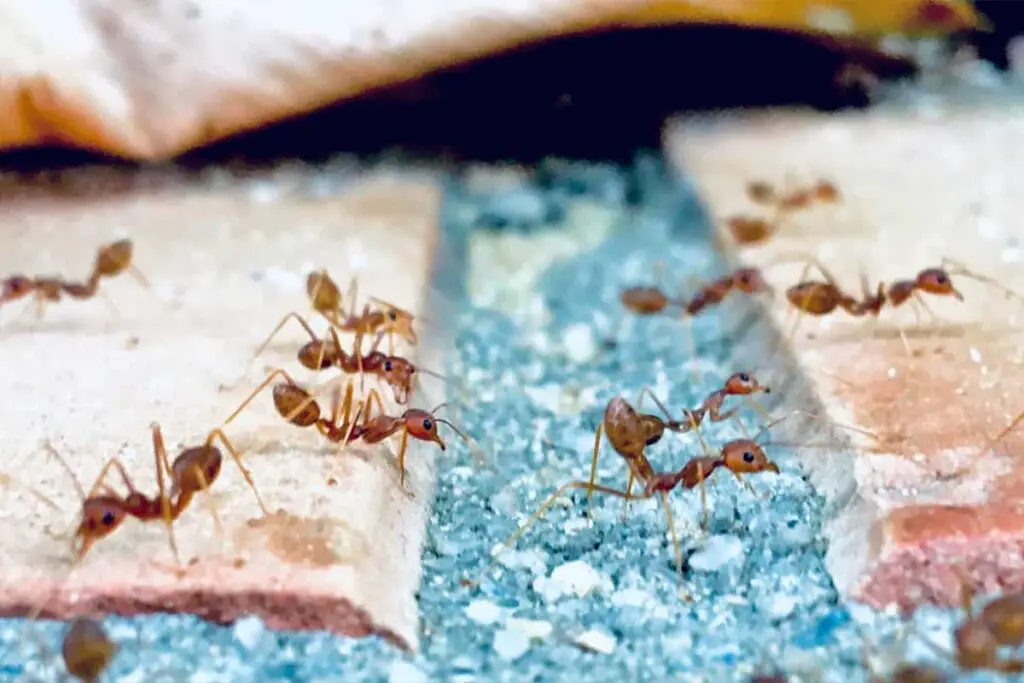
Ants are a common sight in many environments, but not all ants are created equal. You might notice differences in color, behavior, and where they build their homes. Specifically, the red ants and fire ants in your backyard each have distinct characteristics that set them apart. Understanding these differences is crucial, as it will help you identify them and manage any potential issues they may cause around your home.
While both red ants and fire ants can show up in the same geographic areas, their impact on your daily life can be quite different. Red ants, often larger and less aggressive, typically don’t sting and cause minimal pain if they do bite. In contrast, fire ants are notorious for their painful, fiery sting that can be a real nuisance. They’re also known for their aggressive nature and can be a significant pest issue, especially in the southern United States.
Characteristics such as size, appearance, and nesting habits are important identifiers. Fire ants, for example, have a reddish-brown color and create large mounds for nests, often disrupting lawns and gardens. By knowing these traits, you can tackle any ant problem more effectively and keep your outdoor spaces more comfortable and enjoyable.
Defining Red Ants
In discussing red ants, it’s important to consider both their diverse species and their environmental preferences, which can vary widely.
Species and Characteristics
Red ants refer to various ant species that share a reddish-brown coloration. While the term “red ant” can be applied broadly, one common example of a red ant species you might encounter is the red carpenter ant. These ants are characterized by their large mandibles and ability to excavate wood to create their nests. Unlike fire ants, red carpenter ants do not sting but can inflict a painful bite. They can range in size from 0.6 to 1.2 cm, which is relatively large for ants.
Habitat and Distribution
Red ants have a wide distribution, thriving in many ecosystems. The red carpenter ant, specifically, is often found in wooded areas where they construct their nests inside moist or decaying wood. Unlike fire ants that create noticeable mounds, red carpenter ant colonies are generally hidden from view, within structures or fallen trees, and are more common in the northeastern and Pacific coastal regions of the United States. They usually prefer forests and other wooded environments but can also be found in your backyard, assuming the conditions suit their nesting habits.
Defining Fire Ants
Before diving in, you should know that fire ants are more than just a nuisance; they’re a widespread and aggressive species with unique characteristics that set them apart from other ants.
Species and Characteristics
Fire Ants belong to the genus Solenopsis. There are several species of fire ants, but the one that often comes to mind is the Solenopsis invicta, known as the red imported fire ant. These ants are identifiable by their reddish-brown color and range in size typically from 1/8 inch to 1/4 inch in length. They have a two-segmented body and a distinct, narrow “waist” between the thorax and abdomen, known as a petiole.
Habitat and Distribution
Fire ants thrive in warm climates and are prevalent in areas such as the southeastern United States, where they were accidentally introduced in the 1930s. These insects are highly adaptable, creating large mounds that can be identified easily in open areas such as lawns and parks. They favor moist environments, yet they can survive in a variety of conditions, even flooding, by forming a living raft with their bodies to escape.
Behavioral Differences
In understanding red ants and fire ants, you’ll note key behavioral differences that affect how they interact with their environment and with humans. These behaviors can influence the ants’ impact on ecosystems and their management in human-inhabited areas.
Colony Structure
Fire ants exhibit a complex colony structure, often consisting of multiple mounds without visible openings, linked to a single colony. This structure contrasts with other red ants, which typically have simpler and less extensive networks. By recognizing these distinct mounds, you can identify potential fire ant presence.
Feeding Habits
Your experience with fire ants may also differ when observing their feeding habits. Fire ants are omnivorous with a strong preference for proteins and fats, which can lead them to invade your picnic or kitchen. On the other hand, some red ants may be more focused on plant-based materials or specific types of food, making them less intrusive to your outdoor activities.
Aggression Levels
Lastly, the aggression levels in fire ants are notably higher. When disturbed, they quickly become defensive and can inflict painful stings. This is quite different from other red ants, which might be less aggressive and slower to bite or sting. Always exercise caution around fire ant mounds to avoid their aggressive defense mechanisms.
Impact on Ecosystem
In understanding the roles of red and fire ants within ecosystems, you’ll find their influences extend from ecological dynamics to economic ramifications.
Ecological Role
Red ants contribute to soil aeration, decomposition, and nutrition cycles through their activities. Their nests improve soil structure and fertility by redistributing nutrients. However, when addressing fire ants, specifically the red imported fire ant, it’s evident that their aggressive nature can disrupt local fauna and outcompete native ant species, leading to decreased biodiversity.
Economic Consequences
The economic consequences of fire ant invasions are significant. Your agricultural and urban areas may experience costly damages. Fire ants can harm crops, livestock, and wildlife, with control expenses and agricultural losses in the United States estimated in the billions. Their presence in electrical equipment can lead to short circuits, increasing maintenance and replacement costs.
Frequently Asked Questions
In this section, you’ll find answers to common queries about distinguishing between red ants and fire ants, understanding their behavior, and what actions to take if you come across these insects.
How can you differentiate between red ants and fire ants?
Red ants are often confused with fire ants due to their color. However, red ants are typically larger, ranging from 1/4 to 1/2 inch in length, and have one small bump or petiole. Fire ants are slightly smaller, with a two-segmented body that gives them a distinctive waist.
What are the characteristics of a fire ant bite compared to a red ant bite?
Fire ant bites are known to cause a sharp pain and intense burning sensation, often resulting in a pustule at the bite site. Red ant bites may also be painful, but they lack the venom that makes fire ant bites so distinctive.
Are there any risks associated with red ant stings?
While red ant stings can be painful, they are generally less of a concern than fire ant stings. However, some people may be allergic to red ant venom and can experience severe reactions.
How do red ants, fire ants, and carpenter ants differ in behavior and habitat?
Carpenter ants are larger and differ in color from black to reddish brown. They bore into wood to create nests, unlike red or fire ants, which usually build mounds outdoors. Fire ants are more aggressive and can become a significant pest, while red ants keep to themselves unless provoked.
What should you do if you encounter a fire ant nest?
If you encounter a fire ant nest, it’s critical to avoid disturbing it. Disturbance can provoke an aggressive reaction from the colony. Instead, consider contacting a professional pest control service to safely deal with the issue.
Do all species of red ants display aggressive behavior?
Not all red ants exhibit the same level of aggression. Some species tend to be more defensive of their colonies rather than outwardly hostile. Still, it’s wise to keep your distance from any ant nests you find to avoid unwanted stings or bites.
Driven by a passion for those tiny creatures that rule our world, we at Bug Domain strive to be your go-to resource for information on insects.



